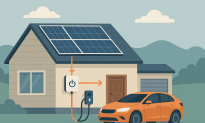 Ride for Free: How to Transfer Solar Energy to Your Electric Vehicle
Ride for Free: How to Transfer Solar Energy to Your Electric Vehicle
Want to skip the gas station forever? With the right setup, your home’s solar panels can directly power your electric vehicle (EV), reducing both your carbon footprint and energy bills. Here’s a homeowner-friendly step-by-step guide to installing a solar system and integrating it with your EV charging infrastructure.
Step 1: Assess Your Home’s Solar Potential
Before you install anything, determine if solar is a good fit for your property:
- Check your roof’s orientation and shading — south-facing, unobstructed roofs are ideal.
- Use free tools like Google Project Sunroof to estimate solar viability.
- Calculate your average electricity usage, including your EV’s needs. For example, charging an EV may add 200–300 kWh per month.
Step 2: Choose the Right Solar System Size
- Match system size to total energy needs, including home + EV.
- A typical household uses ~800 kWh/month; an EV adds ~250–350 kWh.
- That may translate to a 6–10 kW system, depending on your location and efficiency goals.
Rule of Thumb: 1 kW of solar generates ~100–140 kWh/month (varies by region).
Step 3: Hire a Licensed Solar Installer
- Get multiple quotes from certified installers (look for NABCEP certification).
- Choose between:
- Grid-tied system with net metering (most common)
- Off-grid system with battery backup
- Ask if they’ve worked with EV charging integration before.
Tip: Some solar companies now offer bundled packages with EV charger installation.
Step 4: Choose Your EV Charging Setup
Install a Level 2 charger at home — these are 240V units that charge your EV much faster than a standard outlet.
- Recommended brands: Tesla Wall Connector, JuiceBox, ChargePoint Home Flex
- Check compatibility with your EV model
- Choose “solar-aware” smart chargers, which can sync charging with solar output (e.g. Wallbox Pulsar Plus, SolarEdge EV charger)
Step 5: Integrate Your Solar + EV Charging
There are two main ways to integrate:
1. Basic Grid-Tied Setup
- Solar panels feed electricity to your home
- Your EV charger pulls from the grid — excess solar offsets energy costs through net metering
- You “ride for free” as long as your system generates enough energy monthly
2. Direct Solar-to-EV Charging (Advanced)
- Requires a smart EV charger or solar inverter with EV output
- Charges your EV only when solar power is available, avoiding grid use
- Requires system monitoring tools (like SolarEdge, Enphase, or Tesla Powerwall app)
Note: Not all chargers/inverters support this — consult your installer for compatibility.
Step 6: Add Optional Battery Backup (Optional but Powerful)
A home battery (like Tesla Powerwall, LG Chem, or Enphase IQ Battery) can:
- Store excess solar for nighttime charging
- Provide backup power during outages
- Reduce grid reliance even further
This is especially useful if your utility doesn’t offer strong net metering benefits.
Step 7: Apply for Incentives and Rebates
Don’t miss out on savings:
- Federal Solar Tax Credit (ITC): 30% off system + battery cost
- Local utility rebates
- EVSE (Electric Vehicle Supply Equipment) incentives
- Check DSIRE (Database of State Incentives for Renewables & Efficiency): https://www.dsireusa.org
Step 8: Monitor and Optimize
Once installed:
- Use your solar system’s app to track generation
- Monitor your EV charger’s energy use
- Set smart charging schedules to match solar production hours
This ensures you’re truly riding on sunshine — not grid power.
Price Breakdown: Solar + EV Charging System (U.S. Average 2025)
|
Component |
Average Cost |
Notes |
|
Solar Panels (6–10 kW system) |
$12,000 – $20,000 |
Includes inverters, racking, and wiring |
|
Solar Installation Labor |
$5,000 – $8,000 |
Permits, engineering, electrical, crew labor |
|
Inverter (string or micro) |
$1,000 – $3,000 |
Microinverters or hybrid inverters (like SolarEdge) for smart control |
|
Electrical Panel Upgrade (if needed) |
$1,500 – $3,000 |
Required for older homes or to handle EV + solar load |
|
Level 2 EV Charger |
$500 – $1,500 |
Home-use models: JuiceBox, Tesla Wall Connector, ChargePoint, etc. |
|
EV Charger Installation (Labor) |
$600 – $1,200 |
Varies by distance from panel and wall mounting complexity |
|
Home Battery Backup (Optional) |
$9,000 – $15,000 |
Tesla Powerwall, Enphase, LG Chem; includes install |
|
Monitoring System/App |
Usually Included |
SolarEdge, Enphase, or Tesla app for monitoring energy/charging |
|
Permits & Inspections |
$500 – $1,500 |
Required by city/county; varies by location |
|
Federal Tax Credit (30%) |
-$6,000 to -$15,000 |
Covers solar system + battery + EVSE installation |
Total System Cost (Before Incentives)
- Without Battery Backup: $19,000 – $35,000
- With Battery Backup: $28,000 – $50,000
After 30% Federal Tax Credit
- Without Battery: $13,300 – $24,500
- With Battery: $19,600 – $35,000
Notes:
- These are average national figures — pricing varies by region, roof complexity, installer markup, and product choice.
- Many states and utilities offer additional rebates, which can reduce net costs further.
- A home using 800–1,200 kWh/mo and driving 1,000 miles/month could save $1,500–$2,500/year in energy and fuel — meaning this system may pay for itself in 7–10 years (or less with incentives).
